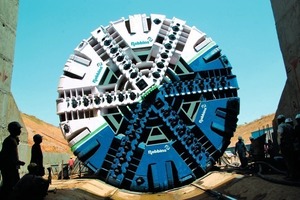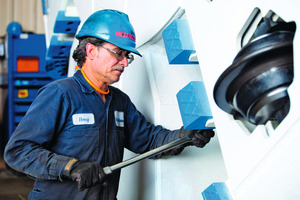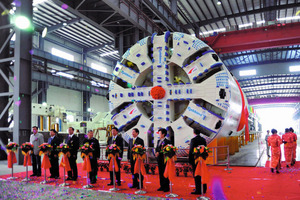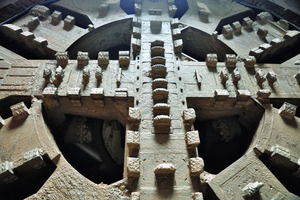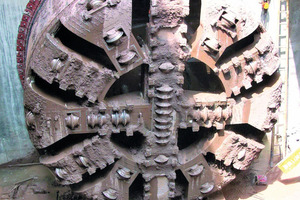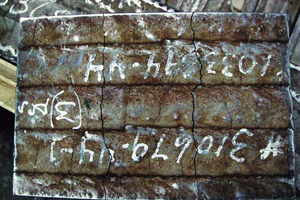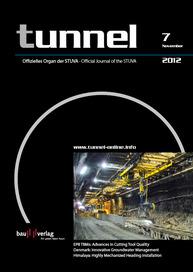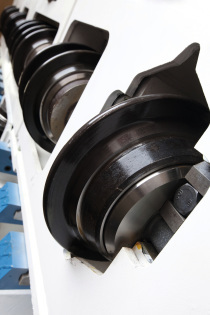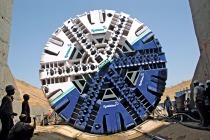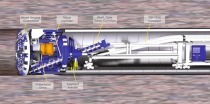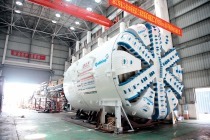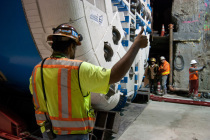Reducing the Cutterhead Wear at EPB Tunnel Boring Machines
The following article shows how Advances of Quality and Configuration for Cutting Tools may reduce the Cutterhead Wear at EPB Tunnel Boring Machines.
Large boulders, abrasive ground, and continuous mixed face conditions: It’s a perfect storm that can maximize wear on an EPB cutterhead and result in increased downtime or even cost overruns. This scenario need not materialize, how-ever, if proper reinforcements are made to the cutterhead, in conjunction with additives and rigorous tool monitoring. Advances in cutting tool quality and configurations, protective wear plating, wear detection devices, and chemicals now provide the necessary options to prevent excessive cutterhead wear. These practices have been used on EPB Tunnel Boring Maschines of Robbins worldwide in a wide variety of conditions, with positive results.
When the Ground gets Tough
Ground conditions are the main cause of rapid wear on an EPB cutterhead. Highly abrasive ground, as indicated from accurate geologic tests or a GBR, as well as boulders, mixed hard rock, and mixed face conditions are the major culprits. These types of geology, in addition to unexpected conditions, call for special measures to be taken for wear protection of the cutterhead. In addition, the predicted conditions can be used to give fairly accurate time estimates for replacement and inspection of cutting tools.
Robbins engineers additionally use this estimate to determine the cutterhead type - whether that be a spoke-type or mixed ground configuration. If all expected geology is under 20 MPa UCS, then disc cutters are not needed and a spoke-type cutterhead can be provided. Spoke-type cutterheads have the advantage of a much larger opening ratio compared to mixed ground cutterheads (usually 60 to 65 %, compared with mixed face designs that clock in at 30 to 35 %). This larger opening ratio means spoke-type heads experience less wear, and require less torque and thrust from the machine. Other benefits of the spoke-type cutterhead include better face pressure control and faster advance rates. However, the main disadvantage of the design is also in its openness - the larger opening ratio provides less protection for workers during tool changes in hyperbaric conditions.
In harder ground and more difficult mixed face conditions, a mixed ground cutterhead can be designed that limits muck flow into the cutterhead chamber and allows for the use of disc cutters. While this type of design can effectively excavate very difficult ground, it will experience greater wear without the proper reinforcement and additive application. Tool consumption estimates can additionally aid in recommending the proper chemical additives and frequency of injection needed for optimal tool wear.
Choosing the Right Tools
Of all aspects of EPB cutterhead design, none may be more imperative than the correct choice of cutting tools. Cutting tools on an EPB are not only for excavating the ground, but also for protection of the cutterhead structure. If tools are left unchecked and allowed to wear off completely, then the cutterhead structure itself will come into contact with and begin to excavate the ground. In this scenario, machine thrust rises, advance rate slows, and wear to the cutterhead structure increases substantially. Cutting tools can be replaced on the cutterhead, but repair to the cutterhead structure is very difficult, expensive, and time consuming.
Optimal primary protection for EPB cutterheads is the replaceable knife bit. These knife bits come in standard duty and heavy duty, though standard duty is typically recommended only for softer geology. These tools are replaced relatively quickly once they are accessed from behind the cutterhead, but they require interventions to inspect and replace; thus, it is better to choose the highest quality knife bits in order to minimize interventions. Typical knife bits are composed of 8 layers of tungsten carbide inserts, a proprietary alloy steel shank, and a complete coating of hard facing. These replaceable knife bits are then welded to a base plate assembly that is wedge-locked into the cutterhead.
Engineers add shorter secondary knife bits in the same path as the primary knife bits to prevent wear from rapidly advancing to the cutterhead structure if the primary knife bits wear out. Cutterhead spokes are designed to alternate between primary and secondary knife bits. Consistent radial spacing of these primary cutting tools is efficient in the breaking up of soft ground. When hard rock or boulders are expected and a mixed ground head is used, these tools can be designed as interchangeable with disc cutters. The same radial spacing principle enables the discs to fracture and break the rock through kerf cutting.
Managing Tool Wear
While cutting tool wear is a normal process of excavation, detection of that wear can make the difference between a successful project and one that is behind schedule. The installation of wear detectors at varying heights on the face of the cutterhead can give warning of excessive wear or of the need to replace cutting tools before damage occurs. Wear detectors use hydraulic pressure that is released when a certain amount of wear occurs and the hydraulic line is sheared, sending a signal to the machine operator.
Varying cutting tool and scraper height arrangements are used on cutterheads depending on the geology, and thus detection can occur at various stages of wear. The most important detection point is at the scraper tips - if cutterhead wear reaches the scraper tips, then the operator knows the knife bits have worn out completely and that the scrapers have started taking over the work. Scrapers are not designed to excavate, but to bring in material excavated by the knife bits, therefore, they will quickly wear if the knife bits are lost. There are many scrapers on any given EPB cutterhead, and replacement of these tools can become very costly and time consuming. To avoid this scenario, wear detectors should be taller than the scraper tips to give an advance warning that knife bits are at the end of their usable life and need to be replaced.
Another very important wear detector type is the wear tube. This tube is routed along the surface of the cutterhead structure beginning in the center and extending to the outermost segments of the cutterhead. The wear tube is protected by cutterhead wear plate on all sides. During tunnelling, the wear tube detects pinpoint failures of a primary cutting tool, which can result in localized wear to the cutterhead. If, for example, a primary knife bit is lost, wear to the cutterhead structure will occur radially in the shape of a ring on the cutterhead face. The wear tube also utilizes hydraulic pressure to indicate that the cutterhead structure is in danger of becoming damaged, and to allow the crew to replace the tool and prevent such an occurence.
Armor Plating
Wear plate is one of the essential cutterhead reinforcements in abrasive mixed ground and rocky conditions. The optimal design for EPB cutterheads includes full protection with an outer layer of wear plate. Many different grades of wear plate are used, depending on several variables including expected abrasivity of the ground, project requirements, and cost. Wear plate materials may include Trimay, chromium, tungsten carbide, or boron carbide, which are not part of the cutterhead structure but are added onto it like armor. For optimal protection, wear plate should cover the entire exposed front surface of the cutterhead that is not shared with a cutting tool or a chemical injection port. In abrasive conditions cutterhead periphery protection, such as side protection bits and additional hard facing, are also recommended.
These wear plate materials are unusual in that they are inherently riddled with cracks - a process that occurs naturally as the carbide material cools after it has been welded to the cutterhead. Extensive experience shows that these cracks are normal and not a defect: they do not propagate, even under impact loading causing deformation to the plate.
Wear plating has been instrumental in protecting multiple Robbins EPB and hard rock cutterheads, including those of three 8.93 m diameter mixed ground machines operating at Mexico City’s Emisor Oriente Wastewater Tunnel. Extensive wear plating on the cutterheads has enabled the machines to effectively excavate in some of the most difficult ground on Earth: Boulders up to 600 mm in diameter, abrasive basalt, and sticky lake clays at pressure up to 6 bar.
Additives aren’t just an Add-on
Chemical additives play a critical role in protecting the EPB cutterhead, as extensive wear can and will occur even with adequate plating and cutting tools. The original chemical additive for soft ground TBMs was Bentonite, which both reduced wear and allowed a free flow of excavated material. While Bentonite is useful in nearly all geological conditions, its drawbacks include cost and toxicity - disposal of Bentonite is strictly regulated in many countries. Alternative additives such as foam, polymer, and anti-clay agents are now used quite often to provide focused ground treatment at a lower cost, and with easier removal.
To aid in additive injection, each EPB cutterhead must be designed with certain port sizes and locations. Independent injection ports on TBMs are capable of dispensing foam, polymer, Bentonite, or any mix of these, and are spaced radially from the center to the periphery of the cutterhead. Independent lines minimize the risk of clogging that can lead to uneven wear, while protection bits and hard facing placed on either side of each port minimize abrasion loss.
Hard Projects in Mixed Ground: EPB Case Studies
Great reductions in wear and increases in production have been seen when contractors utilize a custom-designed cutterhead and inject the recommended chemical additives, even in difficult conditions. Examples of EPB cutterheads that have emerged with minimal wear after kilometers of excavation have been observed on multiple projects around the world.
Challenging Chengdu
The new Chengdu Metro Line 2 stretches 31.6 km through a complex matrix of alluvial geology found nowhere else in China. In 2009, a 6.3 m diameter Robbins EPB was designed to excavate the highly permeable ground, consisting of lenses and layers of glacial boulders up to 25 cm in diameter, along with sand and stiff clay.
To excavate in the conditions, a mixed ground cutterhead was provided, mounted with interchangeable carbide bits and seven 17-inch (432 mm) diameter disc cutters around the gauge, as well as hard facing. The large cutterhead opening ratio allowed for a smooth flow of muck into the mixing chamber. The cutterhead was powered by ten 90 kW variable frequency drives.
The machine was designed with active articulation for curves with radii as small as 500 m. The active configuration was utilized, because it engages articulation cylinders between the front and rear shields in curves to steer the machine independently of the thrust cylinders. The process allows the thrust cylinders to react evenly against all sides of the segment ring during a TBM stroke in a curve. The setup eliminates segment deformation, or racking - a common cause of project delays when passive articulation is used through curves.
A foam injection system was used to stabilize any running ground, with each cubic meter of foam mixture able to stabilize about 40 rings of advance. Four independent injection ports allowed for good control of foam and other additives into the ground at the face.
The TBM excavated mainly through stiff red clays under about 2 bar earth pressure, but also experienced short sections of mixed face rock and earth, particularly while tunnelling 3.5 m below Donggan River. Despite the mixed conditions, only 3 cutter changes were required during boring - 1 cutter change required 1.5 bar of air pressure, while the other 2 were done in free air because the ground was very stable.
The Robbins machine completed tunneling in December 2010, having achieved landmark rates of 129 m in one week, and 459.5 m during its best month - higher rates than at least 4 other machines working on Line 2. The cutterhead notably emerged after 3.2 km of excavation with very minimal wear.
Getting Results in Guangzhou
Two Robbins 6.3 m diameter EPBs began boring Lot 12 of China’s Guangzhou Metro, Guang-Fo line in January and February 2009, through the country’s characteristically complex soils. Ground consisted of layers of highly weathered to slightly weathered granite, coarse sand, and silt at earth pressures up to 4 bar.
The machines were designed for mixed face, variable ground using spoke-type cutterheads with a 37 % opening ratio. Both carbide bits and 17-inch (432 mm) hard rock single disc cutters were used to combat both the clay-like and rocky conditions.
Each EPB cutterhead was driven by 10 variable frequency drive (VFD) electric motors, for a total cutterhead power of 900 kW. Cutterhead rotation was kept low (around 1.5 rpm at maximum), in order to reduce ground disturbance and surface settlement in non-self-supporting geology. At the same time, the machines were designed with high torque to increase the rate of instantaneous penetration in soft ground.
The machines were launched from cut and cover station sites in a densely urban area of Guangzhou. From the start, the viscosity of a red, clayey soil layer was higher than expected, making the mud cake easy to form, but also prone to blocking the central area of the cutterhead. In order to pass through the sticky layer, foam was added to reduce viscosity, while reserve water injection holes inside the man-lock were used to flush any clogged soil from the central cutterhead area. The situation was aided by a system of 4 independent foam injection points on the cutterhead, which prevented clogging of multiple ports on one side of the cutterhead, which can lead to uneven wear.
Despite the mixed ground and other challenges including low cover and sensitive structures, the machines achieved a best month of 377 m - higher than any of the 16 TBMs that worked on the Guangzhou Metro, Guang-Fo Line Project. Both Robbins EPBs completed 4.5 km of tunnelling with little cutterhead wear more than a month early, in September and October 2009.
Conclusions
EPBs are fully capable of excavating highly variable and abrasive ground conditions - with the proper tools, design, and additives. Contractors who work with manufacturers and suppliers to achieve an optimal cutterhead design and a proper additive injection program can expect to experience less wear and better advance rates. As with many aspects of tunneling, success begins with planning, long before the first TBM push.

